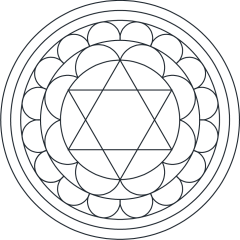सर्वशक्तिमयी सर्वमङ्गला सद्गति-प्रदा ।
सर्वेश्वरी सर्वमयी सर्वमन्त्र-स्वरूपिणी ॥ ५२॥
सर्व-यन्त्रात्मिका सर्व-तन्त्ररूपा मनोन्मनी ।
माहेश्वरी महादेवी महालक्ष्मी-मृडप्रिया ॥ ५३॥
The glory of the mandala has been best described in the Sri Lalithā Sahasranāma, an extraordinary text that extolls the greatness of the Supreme Self in the form of Divine Mother. Mandalas are excellent mediums and tools to improve one’s concentration, overcome stress and trauma, stabilize one’s physical, emotional and mental health and for Realization of the Self.
The pious Rishis in the ancient days spent thousands of years in tapas (penance and austerities) to Realize the Self, to understand the entire gamut of the universe and creation and the concept of Time. Their esoteric knowledge led them to write comprehensive treatises on every conceivable subject in this universe be it astronomy, astrology, quantum physics, medicine, surgery, metallurgy, chemistry, arts, architecture, etc.
These voluminous expositions, commentaries and texts are unmatched repositories of knowledge and wisdom. These guiding beacons have revealed the meaning of mandala, its conception, how to interpret and derive one’s purpose of existence.
The mandala is a precise geometric diagram with a dot/point (called as bindu) in the centre (sometimes a void) and enveloped by either triangles or circles and lotus or floral petals. The ideology behind this is that the dot/point in the centre signifies the Heart Lotus in every being, the Self that remains hidden in this illusive creation known as the universe represented by the concentric circles, petals and triangles. The void in the centre is the Unknown and Unmanifest aspect of the Supreme Self.
A line or circle or arc of a petal is a series of dots/points that form a definitive shape corroborating with the Advaita philosophy that only the SELF EXISTS. This has been further elucidated by Jagadguru Adi Shankaracharya in His “Brahma Satyam Jagan Mithya Jivo Brahmaiva Na Parah“.
The mandala becomes a yantra when the beeja aksharas are placed in their respective places in the diagram particularly the primordial beeja akshara in the centre. The diagram is enclosed within a square known as the gates with openings in the middle on each side. Thus, the Supreme Self takes the form of a mantra, yantra and tantra as illustrated in the Sri Lalithā Sahasranāma.
Here are a few examples of mandalas:




Written by Lakshmi Subramanian


Leave a comment